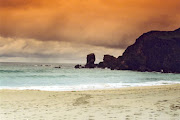On my summer vacations in Dalmore(eight glorious weeks),it was one of my duties to take the cattle up over the hills to the village common grazings,most often to the Gearraidh,where the "grass was greener".Later on in the evenings I would fetch the cows for milking and shelter.The morning outing was a leisurely affair where the cattle were allowed to eat their first fresh grass of the day.Between Beinn Dhaile Mor and Beinn Bhrag ran a small stream called the Allt Garbh(rugged/harsh stream).I only know that name from an old map and it was anything but rugged in July or August.
The allt flows slowly until it reaches the brae overlooking Dalmore Beach,when it descends steeply to the golden sands.Heavy rains can swell this stream to a torrent,carving out large Disneyland sand structures on the beach.Often, when the cattle were drinking from the stream,my attention would be drawn to the iridescent film on the water's surface at the point before the stream plunges down to the sea.The oil here on the surface is caused by a blue clay found here and nowhere else along the river.It was easy to fashion into simple objects,and was similar to potter's clay.I was later to find that it was from here that my Auntie Dollag(Dolina)got the clay to line the fire and the "stacks" in our house.It traspires that others in the village knew of the blue clay at the Allt Garbh,but few could have guessed just how far back in time people were using this self same clay - but we were soon to find out.When I came down to where the allt reached the sand,there was a bank strewn with bits of bone,pieces of unglazed pottery and small pieces of quartz.To me,it was just a rubbish tip of stones,fine bones and "old crockery".In Renfrew I knew what a "midden" was,but what happened many years later here on Dalmore Beach would bring a whole new meaning to that word for me,and the wider world.
In 1978/79 there was a very bad storm, and fierce seas broke through woefully inadequate sea defences and threatened to wash away the southern part of the new cemetry,with all the goulish sights which that might entail.The Council moved fast to shore up the breach,bringing in diggers and other earth moving equipment.A little way into his job,a digger operator stopped suddenly,when he ex posed some readily identifiable ancient site,some meters down in the hard sand.Margaret Ponting(as she was then) and her husband,both respected amateur archaeologists and living at Callanish,were called to the site,and later university experts arrived.They were given six weeks to do some excavations before the shoring up work would resume.What they discovered was the remains of an oval building, hearth and yard,bone and antler tools,shards of pottery of the Beaker Period and earlier Neolithic fragments of around 2000 BC.They think that this was a site where the Callanish people(Megalithic) kept a workshop for making arrowheads from quartz pieces found on the shore.There was very little evidence of fish/animal bones or shells.They concluded that Dalmore was a specialised site,where groups came together in their activities.And they used the blue clay in their pottery !
The dig ended,the sea defences were repaired and strengthened and, should the sea break through again,further archaeology on this site will tell us more about the "Dalmore Workshop". Margaret Curtis(formerly Ponting) still has artefacts from the Dalmore dig of 1978/79 at her museum in Callanish.The major finds went to Edinburgh.The whole dig appeared in "Current Archaeology",Volume 8,No.91,pages 230-235.
Dalmore Daytime

Sandy Beach
Wednesday, 6 February 2008
Subscribe to:
Post Comments (Atom)


No comments:
Post a Comment